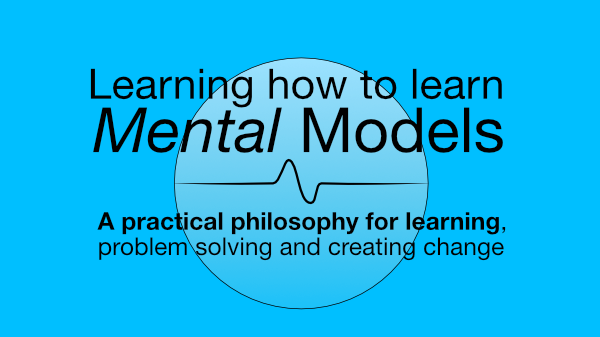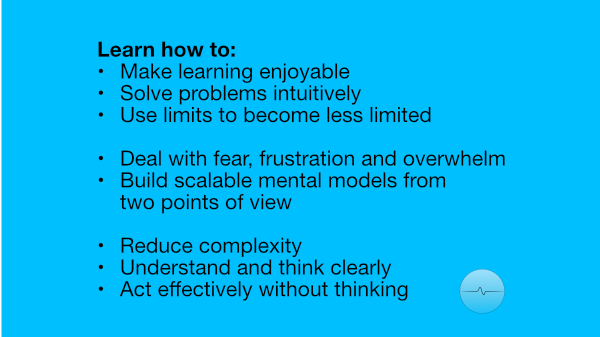Learning how to learn
Mental Models
A practical philosophy for learning, problem solving and creating change
When we learn, mental models are the things in our brains that store what we learn. Part of the process of learning is building these models, another part is indexing them so that what we learn can be called up when needed.
What we learn
Sometimes what we learn is information, or details of how something (as sytem) works. Sometimes what we learn is how to process information to solve problems or otherwise provide answers. And yet another thing that we can learn is things that involve the use of our body. This can include things like riding a motorcycle, driving a car, riding a bike, doing martial arts or dancing, and of course it can also include things like how to do yoga poses and how to move between them.
The same process of learning can be applied to learning external systems and to learning the things that involve ourselves. The trick then is learning how to learn in such a way that learning is easier and more enjoyable, and also more effective.
The meaning of effective learning
Effective in this case can mean several things. It can mean learning in a way that we don't have to spend so much time learning. It can also mean learning in such a way that we can re-use what we've learned. But, and this is particularly true when solving problems, or otherwise coming up with elegant solutions or creations, it means building models from two points of view.
Building mental models from two points of view
Learning How to Learn Mental models is about the process of building mental models from two points of view. With this process, self-testing is an integral part of the process. But so too is breaking things down.
Applied to ourselves and learning the things that involve ourselves, we can improve our ability to think clearly but also our ability to enjoy our experiences even as we work to improve them. We can thus work at gradually improving our lives, if we choose, as well as out ability to solve problems. In terms of activities that involve our direct involvement, we can learn the basics of feeling our body and better controlling it.
30 Day Guarantee
If you aren't satisfied, let me know within 30 days of purchase and I'll give you your money back. My email is included in the receipt when you make your purchase.
Buy now from Gumroad
Table of contents
Mental models and learning, an introduction
Learning allows us to improve our experiences
We can't solve problems unless we can learn
Mental models are the result of all that we learn
Learning to act effectively without thinking
Four categories of mental models
Habits are model outputs
An example of unthinking action
Freeing up attention
Triggers
Options
Micro habits
Reducing frustration
Programming ourselves
Iterative learning
Building models ahead of time
Separating learning from doing
The importance of indexing
Indexing is a part of learning
Doing simple math
Fixing problems with math
Fixing problems with indexing
Indexing with varied references
Answering 100 questions quickly
Dancing with chaos
Breaking things down
Action Frameworks
Learning to ride a motorbike
Practicing in different contexts
Building the model first
Memorizing an initial model
Checking the results
Building a model or improving it
Recognizing a problem
Sharpening the thinking mind
Two mind-states
Separating thinking and doing
Thinking
Sensing
Cycling between mind-states
Building then using
Practice
Defining Practice
Using limits to approach limitlessness
Guidelines for testing
Improving sensitivity and control
Practicing mind-state control
Using then checking
Learning sensitivity
Improving control
Short term memory
It's limited
Don't overstuff the airlock
Mid-term memory
Learning to write Chinese characters
Listening in chunks
Assembling a model in mid-term memory
Five Items or Less
Being specific
Making choices
Noticing relationships
Aiding effective indexing
Freeing ourselves from the limits of short term memory
Using references to previously learned models
Learning re-usable components
Choosing how we learn and what we learn from
Learning to improve the model building process
Using external memory
Programming
Programming with short term memory in mind
Making our writing easier to edit
Reducing redundancy
Stepping back
Sensing change
Recognizing
Weight shifting
Learning to sense
Doing math and Tai Ji without thinking
Positioning to maximize sensitivity
The dangers of thinking
Overcoming fear
Directing our senses
Change doesn't stop
Types of change
Sensing change inside and outside of ourselves
Sensory horizons
Maximizing the sensory horizon
Sensing change early via the outer environment
Configuring for responsiveness
Directing our senses externally
Directing our senses internally
Tuning and adjusting
Creating sensation first
Two points of view
Defining a system
Components and how they relate
Modelling the system as it is working
Components and signals
An example of the effectiveness of models created using two points of view
A Feynman-like view of understanding
Laplace transforms
What understanding is made of
The complex number plane
Two points of view, time and space
Stepping in and out of the flows of time
Detecting hinderances to the flow of change
Checking our solution and our models in general
Becoming a better reader
Reading is a fluid process
Looking back on the experience
Interacting with our models outside of habbits
Intuition as the output of our models
Inner space
Resting
Fracticality
Writing Chinese characters or understanding them
Riding a bike or fixing it
Learning to feel our body
A Dauntless approach to modeling systems
Dealing with overwhelm
Recognizing completion
Ideas
Defining an idea
Systems as ideas
Ideas as imaginary or real
Being like water
Thinking clearly
Relationships
Connection
Ideas and relationships are fracticality optional
Systems versus relationships
Relationships
Room to sense change and room to create it
Prototyping
The reverse of building a mental model
To create a desired change we need a foundation
Two points of view
Contexting and Two Points of View
Defining and Redefining Systems (and Models)
Identity and Recognition
Experiencing and then Reviewing the Experience
Breaking it down ahead of time
The components as landmarks
Choosing how to differentiate and break down
Breaking down in terms of ideas that create, sense or otherwise transmit change
Grasp swallow's tail
Providing context
Memory techniques
Flexible labelling
Modelling our own body
How muscles act as force sensors
Learning our body
Focusing on the targeted area
Muscle model basics
Defining muscle stretch
Anchoring one end of a stretch
Options for muscle anchoring
Another way to think of flexibility
Creating room to move aka sufficient operating length
Connecting to our muscles
One way to create stability
Turning stability into direct-ability or control
Basic principles and First Principles
Systems create change
Ideas, relationships and change
Basic principles
Connections create relationships
Room to move
Foundation
Creating change
First principles
Limits and limitlessness
Limits in the thinking mode
Limits in the fluid mode
Handling change
Creating
Buy now from Gumroad
Published: 2023 03 31




